Research Proposal: Customer Experience and Engagement in Hospitality
VerifiedAdded on 2021/02/21
|11
|3074
|27
Project
AI Summary
This research proposal investigates customer experience and customer engagement within the Scottish hospitality industry, focusing on how technology shapes the consumer journey. The background highlights the importance of customer experience in the hospitality sector, emphasizing the need for personalized and high-quality service to meet evolving customer expectations. The objectives aim to explore current trends, examine strategies, and assess challenges in the Scottish hospitality industry, focusing on how technology influences customer engagement. The rationale emphasizes the need to address service quality gaps and improve customer satisfaction. The literature review explores latest trends, strategies used by hospitality sectors and challenges faced by the Scottish hospitality industry. The methodology outlines a qualitative research approach using interpretivism and an inductive approach, collecting primary and secondary data through questionnaires and a random sample of 20 customers. This research aims to provide insights into improving customer experience and engagement, and to address key challenges and opportunities in the Scottish hospitality sector.

RESEARCH PROPOSAL
Paraphrase This Document
Need a fresh take? Get an instant paraphrase of this document with our AI Paraphraser
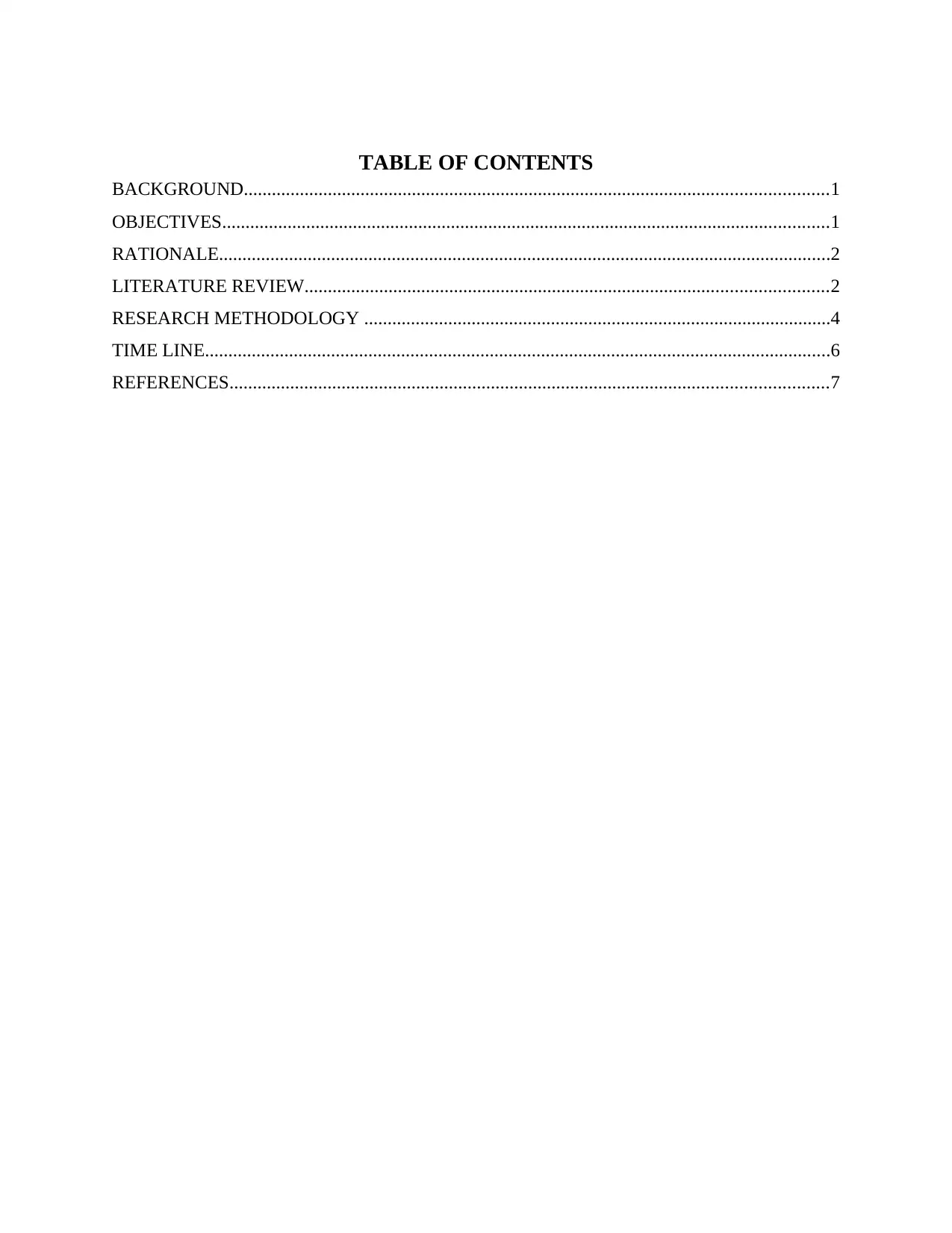
TABLE OF CONTENTS
BACKGROUND.............................................................................................................................1
OBJECTIVES..................................................................................................................................1
RATIONALE...................................................................................................................................2
LITERATURE REVIEW................................................................................................................2
RESEARCH METHODOLOGY ....................................................................................................4
TIME LINE......................................................................................................................................6
REFERENCES................................................................................................................................7
BACKGROUND.............................................................................................................................1
OBJECTIVES..................................................................................................................................1
RATIONALE...................................................................................................................................2
LITERATURE REVIEW................................................................................................................2
RESEARCH METHODOLOGY ....................................................................................................4
TIME LINE......................................................................................................................................6
REFERENCES................................................................................................................................7
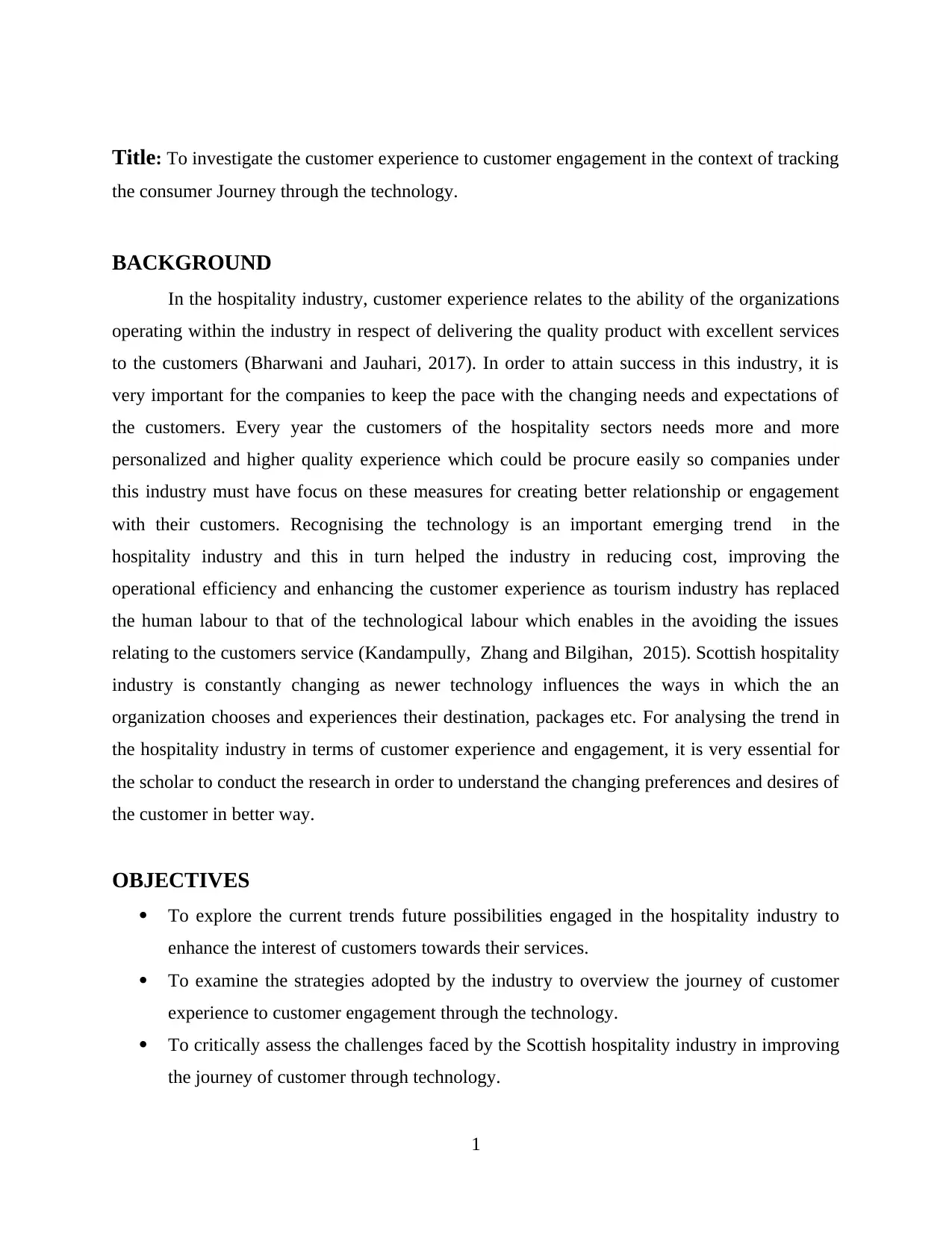
Title: To investigate the customer experience to customer engagement in the context of tracking
the consumer Journey through the technology.
BACKGROUND
In the hospitality industry, customer experience relates to the ability of the organizations
operating within the industry in respect of delivering the quality product with excellent services
to the customers (Bharwani and Jauhari, 2017). In order to attain success in this industry, it is
very important for the companies to keep the pace with the changing needs and expectations of
the customers. Every year the customers of the hospitality sectors needs more and more
personalized and higher quality experience which could be procure easily so companies under
this industry must have focus on these measures for creating better relationship or engagement
with their customers. Recognising the technology is an important emerging trend in the
hospitality industry and this in turn helped the industry in reducing cost, improving the
operational efficiency and enhancing the customer experience as tourism industry has replaced
the human labour to that of the technological labour which enables in the avoiding the issues
relating to the customers service (Kandampully, Zhang and Bilgihan, 2015). Scottish hospitality
industry is constantly changing as newer technology influences the ways in which the an
organization chooses and experiences their destination, packages etc. For analysing the trend in
the hospitality industry in terms of customer experience and engagement, it is very essential for
the scholar to conduct the research in order to understand the changing preferences and desires of
the customer in better way.
OBJECTIVES
To explore the current trends future possibilities engaged in the hospitality industry to
enhance the interest of customers towards their services.
To examine the strategies adopted by the industry to overview the journey of customer
experience to customer engagement through the technology.
To critically assess the challenges faced by the Scottish hospitality industry in improving
the journey of customer through technology.
1
the consumer Journey through the technology.
BACKGROUND
In the hospitality industry, customer experience relates to the ability of the organizations
operating within the industry in respect of delivering the quality product with excellent services
to the customers (Bharwani and Jauhari, 2017). In order to attain success in this industry, it is
very important for the companies to keep the pace with the changing needs and expectations of
the customers. Every year the customers of the hospitality sectors needs more and more
personalized and higher quality experience which could be procure easily so companies under
this industry must have focus on these measures for creating better relationship or engagement
with their customers. Recognising the technology is an important emerging trend in the
hospitality industry and this in turn helped the industry in reducing cost, improving the
operational efficiency and enhancing the customer experience as tourism industry has replaced
the human labour to that of the technological labour which enables in the avoiding the issues
relating to the customers service (Kandampully, Zhang and Bilgihan, 2015). Scottish hospitality
industry is constantly changing as newer technology influences the ways in which the an
organization chooses and experiences their destination, packages etc. For analysing the trend in
the hospitality industry in terms of customer experience and engagement, it is very essential for
the scholar to conduct the research in order to understand the changing preferences and desires of
the customer in better way.
OBJECTIVES
To explore the current trends future possibilities engaged in the hospitality industry to
enhance the interest of customers towards their services.
To examine the strategies adopted by the industry to overview the journey of customer
experience to customer engagement through the technology.
To critically assess the challenges faced by the Scottish hospitality industry in improving
the journey of customer through technology.
1
⊘ This is a preview!⊘
Do you want full access?
Subscribe today to unlock all pages.

Trusted by 1+ million students worldwide
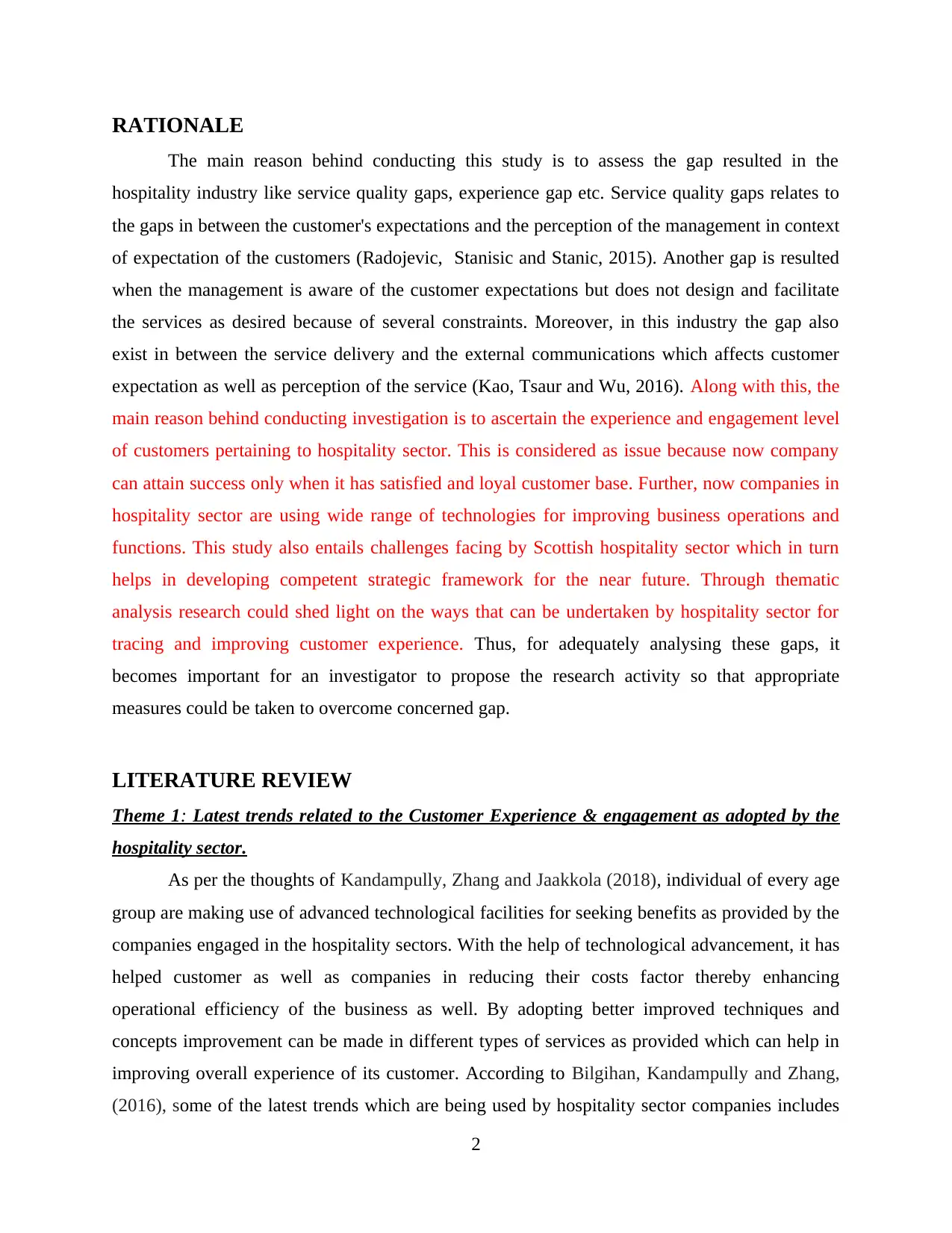
RATIONALE
The main reason behind conducting this study is to assess the gap resulted in the
hospitality industry like service quality gaps, experience gap etc. Service quality gaps relates to
the gaps in between the customer's expectations and the perception of the management in context
of expectation of the customers (Radojevic, Stanisic and Stanic, 2015). Another gap is resulted
when the management is aware of the customer expectations but does not design and facilitate
the services as desired because of several constraints. Moreover, in this industry the gap also
exist in between the service delivery and the external communications which affects customer
expectation as well as perception of the service (Kao, Tsaur and Wu, 2016). Along with this, the
main reason behind conducting investigation is to ascertain the experience and engagement level
of customers pertaining to hospitality sector. This is considered as issue because now company
can attain success only when it has satisfied and loyal customer base. Further, now companies in
hospitality sector are using wide range of technologies for improving business operations and
functions. This study also entails challenges facing by Scottish hospitality sector which in turn
helps in developing competent strategic framework for the near future. Through thematic
analysis research could shed light on the ways that can be undertaken by hospitality sector for
tracing and improving customer experience. Thus, for adequately analysing these gaps, it
becomes important for an investigator to propose the research activity so that appropriate
measures could be taken to overcome concerned gap.
LITERATURE REVIEW
Theme 1: Latest trends related to the Customer Experience & engagement as adopted by the
hospitality sector.
As per the thoughts of Kandampully, Zhang and Jaakkola (2018), individual of every age
group are making use of advanced technological facilities for seeking benefits as provided by the
companies engaged in the hospitality sectors. With the help of technological advancement, it has
helped customer as well as companies in reducing their costs factor thereby enhancing
operational efficiency of the business as well. By adopting better improved techniques and
concepts improvement can be made in different types of services as provided which can help in
improving overall experience of its customer. According to Bilgihan, Kandampully and Zhang,
(2016), some of the latest trends which are being used by hospitality sector companies includes
2
The main reason behind conducting this study is to assess the gap resulted in the
hospitality industry like service quality gaps, experience gap etc. Service quality gaps relates to
the gaps in between the customer's expectations and the perception of the management in context
of expectation of the customers (Radojevic, Stanisic and Stanic, 2015). Another gap is resulted
when the management is aware of the customer expectations but does not design and facilitate
the services as desired because of several constraints. Moreover, in this industry the gap also
exist in between the service delivery and the external communications which affects customer
expectation as well as perception of the service (Kao, Tsaur and Wu, 2016). Along with this, the
main reason behind conducting investigation is to ascertain the experience and engagement level
of customers pertaining to hospitality sector. This is considered as issue because now company
can attain success only when it has satisfied and loyal customer base. Further, now companies in
hospitality sector are using wide range of technologies for improving business operations and
functions. This study also entails challenges facing by Scottish hospitality sector which in turn
helps in developing competent strategic framework for the near future. Through thematic
analysis research could shed light on the ways that can be undertaken by hospitality sector for
tracing and improving customer experience. Thus, for adequately analysing these gaps, it
becomes important for an investigator to propose the research activity so that appropriate
measures could be taken to overcome concerned gap.
LITERATURE REVIEW
Theme 1: Latest trends related to the Customer Experience & engagement as adopted by the
hospitality sector.
As per the thoughts of Kandampully, Zhang and Jaakkola (2018), individual of every age
group are making use of advanced technological facilities for seeking benefits as provided by the
companies engaged in the hospitality sectors. With the help of technological advancement, it has
helped customer as well as companies in reducing their costs factor thereby enhancing
operational efficiency of the business as well. By adopting better improved techniques and
concepts improvement can be made in different types of services as provided which can help in
improving overall experience of its customer. According to Bilgihan, Kandampully and Zhang,
(2016), some of the latest trends which are being used by hospitality sector companies includes
2
Paraphrase This Document
Need a fresh take? Get an instant paraphrase of this document with our AI Paraphraser
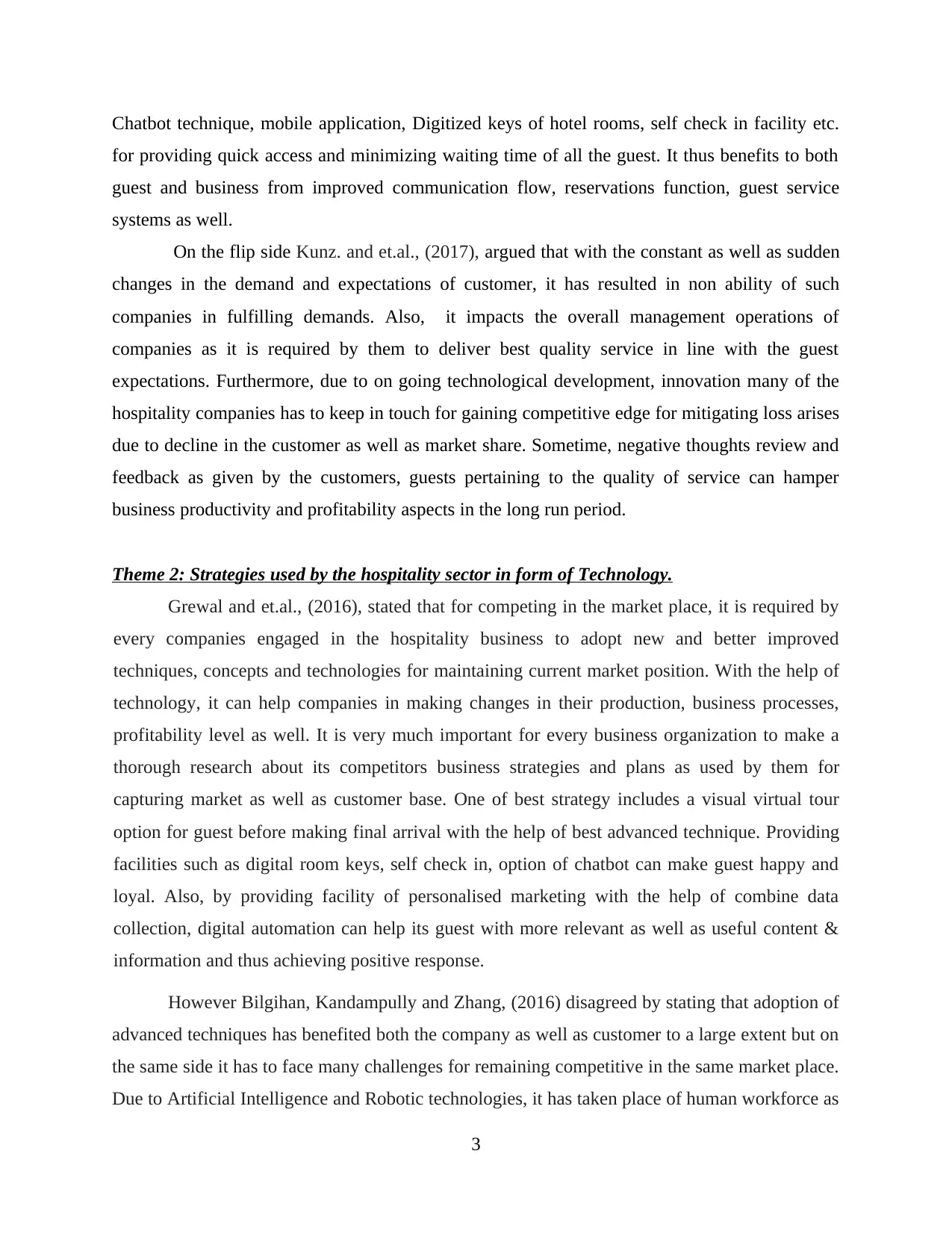
Chatbot technique, mobile application, Digitized keys of hotel rooms, self check in facility etc.
for providing quick access and minimizing waiting time of all the guest. It thus benefits to both
guest and business from improved communication flow, reservations function, guest service
systems as well.
On the flip side Kunz. and et.al., (2017), argued that with the constant as well as sudden
changes in the demand and expectations of customer, it has resulted in non ability of such
companies in fulfilling demands. Also, it impacts the overall management operations of
companies as it is required by them to deliver best quality service in line with the guest
expectations. Furthermore, due to on going technological development, innovation many of the
hospitality companies has to keep in touch for gaining competitive edge for mitigating loss arises
due to decline in the customer as well as market share. Sometime, negative thoughts review and
feedback as given by the customers, guests pertaining to the quality of service can hamper
business productivity and profitability aspects in the long run period.
Theme 2: Strategies used by the hospitality sector in form of Technology.
Grewal and et.al., (2016), stated that for competing in the market place, it is required by
every companies engaged in the hospitality business to adopt new and better improved
techniques, concepts and technologies for maintaining current market position. With the help of
technology, it can help companies in making changes in their production, business processes,
profitability level as well. It is very much important for every business organization to make a
thorough research about its competitors business strategies and plans as used by them for
capturing market as well as customer base. One of best strategy includes a visual virtual tour
option for guest before making final arrival with the help of best advanced technique. Providing
facilities such as digital room keys, self check in, option of chatbot can make guest happy and
loyal. Also, by providing facility of personalised marketing with the help of combine data
collection, digital automation can help its guest with more relevant as well as useful content &
information and thus achieving positive response.
However Bilgihan, Kandampully and Zhang, (2016) disagreed by stating that adoption of
advanced techniques has benefited both the company as well as customer to a large extent but on
the same side it has to face many challenges for remaining competitive in the same market place.
Due to Artificial Intelligence and Robotic technologies, it has taken place of human workforce as
3
for providing quick access and minimizing waiting time of all the guest. It thus benefits to both
guest and business from improved communication flow, reservations function, guest service
systems as well.
On the flip side Kunz. and et.al., (2017), argued that with the constant as well as sudden
changes in the demand and expectations of customer, it has resulted in non ability of such
companies in fulfilling demands. Also, it impacts the overall management operations of
companies as it is required by them to deliver best quality service in line with the guest
expectations. Furthermore, due to on going technological development, innovation many of the
hospitality companies has to keep in touch for gaining competitive edge for mitigating loss arises
due to decline in the customer as well as market share. Sometime, negative thoughts review and
feedback as given by the customers, guests pertaining to the quality of service can hamper
business productivity and profitability aspects in the long run period.
Theme 2: Strategies used by the hospitality sector in form of Technology.
Grewal and et.al., (2016), stated that for competing in the market place, it is required by
every companies engaged in the hospitality business to adopt new and better improved
techniques, concepts and technologies for maintaining current market position. With the help of
technology, it can help companies in making changes in their production, business processes,
profitability level as well. It is very much important for every business organization to make a
thorough research about its competitors business strategies and plans as used by them for
capturing market as well as customer base. One of best strategy includes a visual virtual tour
option for guest before making final arrival with the help of best advanced technique. Providing
facilities such as digital room keys, self check in, option of chatbot can make guest happy and
loyal. Also, by providing facility of personalised marketing with the help of combine data
collection, digital automation can help its guest with more relevant as well as useful content &
information and thus achieving positive response.
However Bilgihan, Kandampully and Zhang, (2016) disagreed by stating that adoption of
advanced techniques has benefited both the company as well as customer to a large extent but on
the same side it has to face many challenges for remaining competitive in the same market place.
Due to Artificial Intelligence and Robotic technologies, it has taken place of human workforce as
3
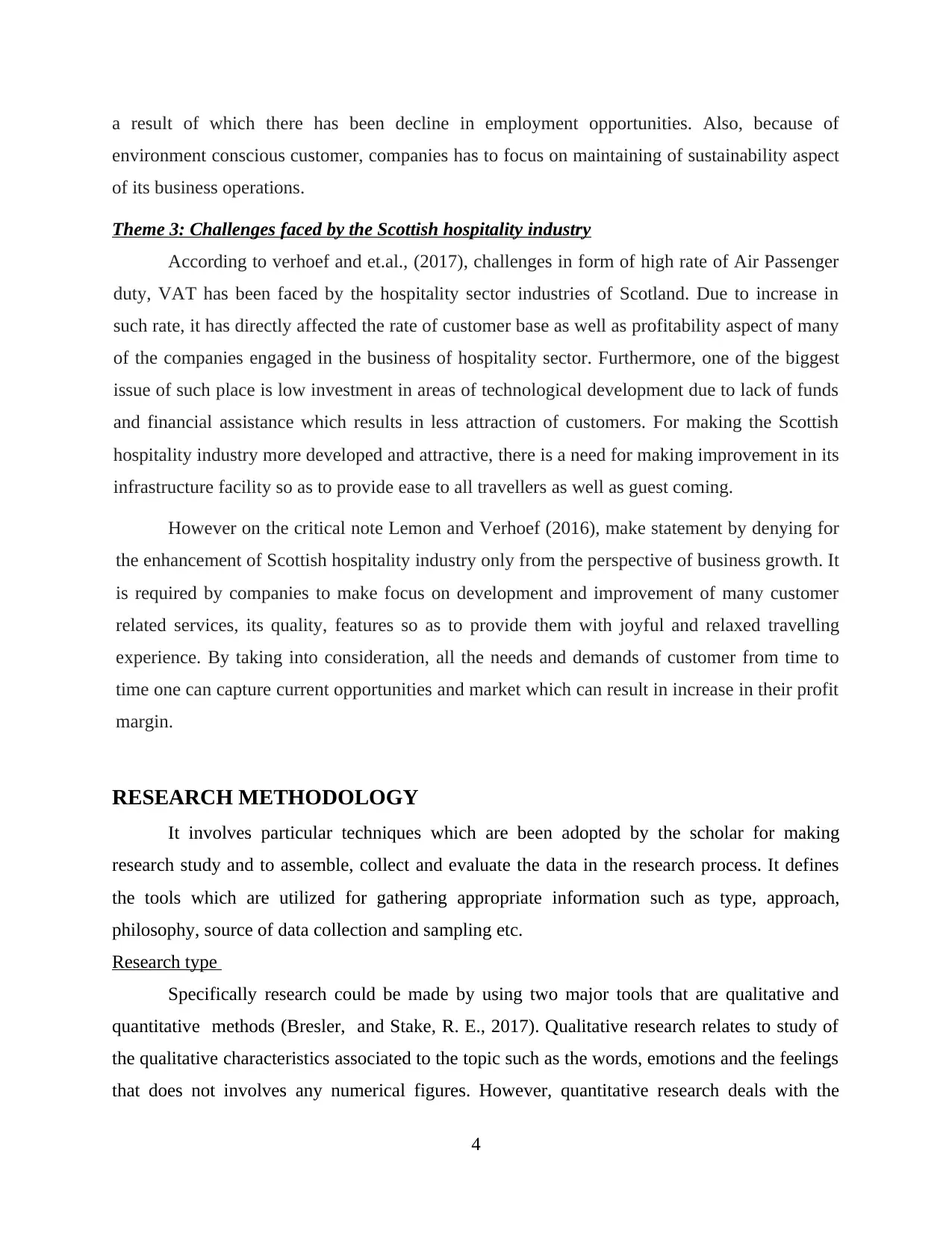
a result of which there has been decline in employment opportunities. Also, because of
environment conscious customer, companies has to focus on maintaining of sustainability aspect
of its business operations.
Theme 3: Challenges faced by the Scottish hospitality industry
According to verhoef and et.al., (2017), challenges in form of high rate of Air Passenger
duty, VAT has been faced by the hospitality sector industries of Scotland. Due to increase in
such rate, it has directly affected the rate of customer base as well as profitability aspect of many
of the companies engaged in the business of hospitality sector. Furthermore, one of the biggest
issue of such place is low investment in areas of technological development due to lack of funds
and financial assistance which results in less attraction of customers. For making the Scottish
hospitality industry more developed and attractive, there is a need for making improvement in its
infrastructure facility so as to provide ease to all travellers as well as guest coming.
However on the critical note Lemon and Verhoef (2016), make statement by denying for
the enhancement of Scottish hospitality industry only from the perspective of business growth. It
is required by companies to make focus on development and improvement of many customer
related services, its quality, features so as to provide them with joyful and relaxed travelling
experience. By taking into consideration, all the needs and demands of customer from time to
time one can capture current opportunities and market which can result in increase in their profit
margin.
RESEARCH METHODOLOGY
It involves particular techniques which are been adopted by the scholar for making
research study and to assemble, collect and evaluate the data in the research process. It defines
the tools which are utilized for gathering appropriate information such as type, approach,
philosophy, source of data collection and sampling etc.
Research type
Specifically research could be made by using two major tools that are qualitative and
quantitative methods (Bresler, and Stake, R. E., 2017). Qualitative research relates to study of
the qualitative characteristics associated to the topic such as the words, emotions and the feelings
that does not involves any numerical figures. However, quantitative research deals with the
4
environment conscious customer, companies has to focus on maintaining of sustainability aspect
of its business operations.
Theme 3: Challenges faced by the Scottish hospitality industry
According to verhoef and et.al., (2017), challenges in form of high rate of Air Passenger
duty, VAT has been faced by the hospitality sector industries of Scotland. Due to increase in
such rate, it has directly affected the rate of customer base as well as profitability aspect of many
of the companies engaged in the business of hospitality sector. Furthermore, one of the biggest
issue of such place is low investment in areas of technological development due to lack of funds
and financial assistance which results in less attraction of customers. For making the Scottish
hospitality industry more developed and attractive, there is a need for making improvement in its
infrastructure facility so as to provide ease to all travellers as well as guest coming.
However on the critical note Lemon and Verhoef (2016), make statement by denying for
the enhancement of Scottish hospitality industry only from the perspective of business growth. It
is required by companies to make focus on development and improvement of many customer
related services, its quality, features so as to provide them with joyful and relaxed travelling
experience. By taking into consideration, all the needs and demands of customer from time to
time one can capture current opportunities and market which can result in increase in their profit
margin.
RESEARCH METHODOLOGY
It involves particular techniques which are been adopted by the scholar for making
research study and to assemble, collect and evaluate the data in the research process. It defines
the tools which are utilized for gathering appropriate information such as type, approach,
philosophy, source of data collection and sampling etc.
Research type
Specifically research could be made by using two major tools that are qualitative and
quantitative methods (Bresler, and Stake, R. E., 2017). Qualitative research relates to study of
the qualitative characteristics associated to the topic such as the words, emotions and the feelings
that does not involves any numerical figures. However, quantitative research deals with the
4
⊘ This is a preview!⊘
Do you want full access?
Subscribe today to unlock all pages.

Trusted by 1+ million students worldwide
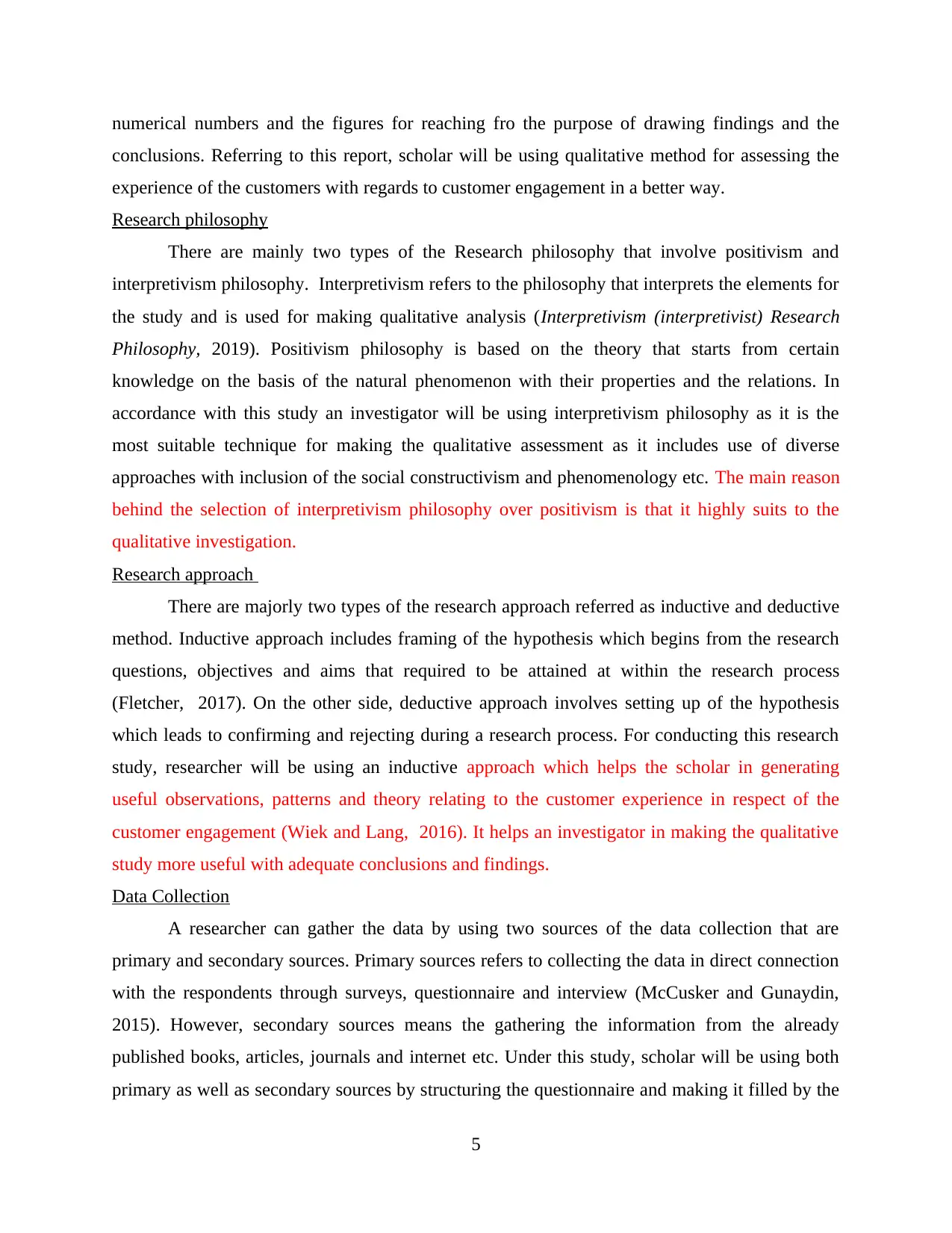
numerical numbers and the figures for reaching fro the purpose of drawing findings and the
conclusions. Referring to this report, scholar will be using qualitative method for assessing the
experience of the customers with regards to customer engagement in a better way.
Research philosophy
There are mainly two types of the Research philosophy that involve positivism and
interpretivism philosophy. Interpretivism refers to the philosophy that interprets the elements for
the study and is used for making qualitative analysis (Interpretivism (interpretivist) Research
Philosophy, 2019). Positivism philosophy is based on the theory that starts from certain
knowledge on the basis of the natural phenomenon with their properties and the relations. In
accordance with this study an investigator will be using interpretivism philosophy as it is the
most suitable technique for making the qualitative assessment as it includes use of diverse
approaches with inclusion of the social constructivism and phenomenology etc. The main reason
behind the selection of interpretivism philosophy over positivism is that it highly suits to the
qualitative investigation.
Research approach
There are majorly two types of the research approach referred as inductive and deductive
method. Inductive approach includes framing of the hypothesis which begins from the research
questions, objectives and aims that required to be attained at within the research process
(Fletcher, 2017). On the other side, deductive approach involves setting up of the hypothesis
which leads to confirming and rejecting during a research process. For conducting this research
study, researcher will be using an inductive approach which helps the scholar in generating
useful observations, patterns and theory relating to the customer experience in respect of the
customer engagement (Wiek and Lang, 2016). It helps an investigator in making the qualitative
study more useful with adequate conclusions and findings.
Data Collection
A researcher can gather the data by using two sources of the data collection that are
primary and secondary sources. Primary sources refers to collecting the data in direct connection
with the respondents through surveys, questionnaire and interview (McCusker and Gunaydin,
2015). However, secondary sources means the gathering the information from the already
published books, articles, journals and internet etc. Under this study, scholar will be using both
primary as well as secondary sources by structuring the questionnaire and making it filled by the
5
conclusions. Referring to this report, scholar will be using qualitative method for assessing the
experience of the customers with regards to customer engagement in a better way.
Research philosophy
There are mainly two types of the Research philosophy that involve positivism and
interpretivism philosophy. Interpretivism refers to the philosophy that interprets the elements for
the study and is used for making qualitative analysis (Interpretivism (interpretivist) Research
Philosophy, 2019). Positivism philosophy is based on the theory that starts from certain
knowledge on the basis of the natural phenomenon with their properties and the relations. In
accordance with this study an investigator will be using interpretivism philosophy as it is the
most suitable technique for making the qualitative assessment as it includes use of diverse
approaches with inclusion of the social constructivism and phenomenology etc. The main reason
behind the selection of interpretivism philosophy over positivism is that it highly suits to the
qualitative investigation.
Research approach
There are majorly two types of the research approach referred as inductive and deductive
method. Inductive approach includes framing of the hypothesis which begins from the research
questions, objectives and aims that required to be attained at within the research process
(Fletcher, 2017). On the other side, deductive approach involves setting up of the hypothesis
which leads to confirming and rejecting during a research process. For conducting this research
study, researcher will be using an inductive approach which helps the scholar in generating
useful observations, patterns and theory relating to the customer experience in respect of the
customer engagement (Wiek and Lang, 2016). It helps an investigator in making the qualitative
study more useful with adequate conclusions and findings.
Data Collection
A researcher can gather the data by using two sources of the data collection that are
primary and secondary sources. Primary sources refers to collecting the data in direct connection
with the respondents through surveys, questionnaire and interview (McCusker and Gunaydin,
2015). However, secondary sources means the gathering the information from the already
published books, articles, journals and internet etc. Under this study, scholar will be using both
primary as well as secondary sources by structuring the questionnaire and making it filled by the
5
Paraphrase This Document
Need a fresh take? Get an instant paraphrase of this document with our AI Paraphraser
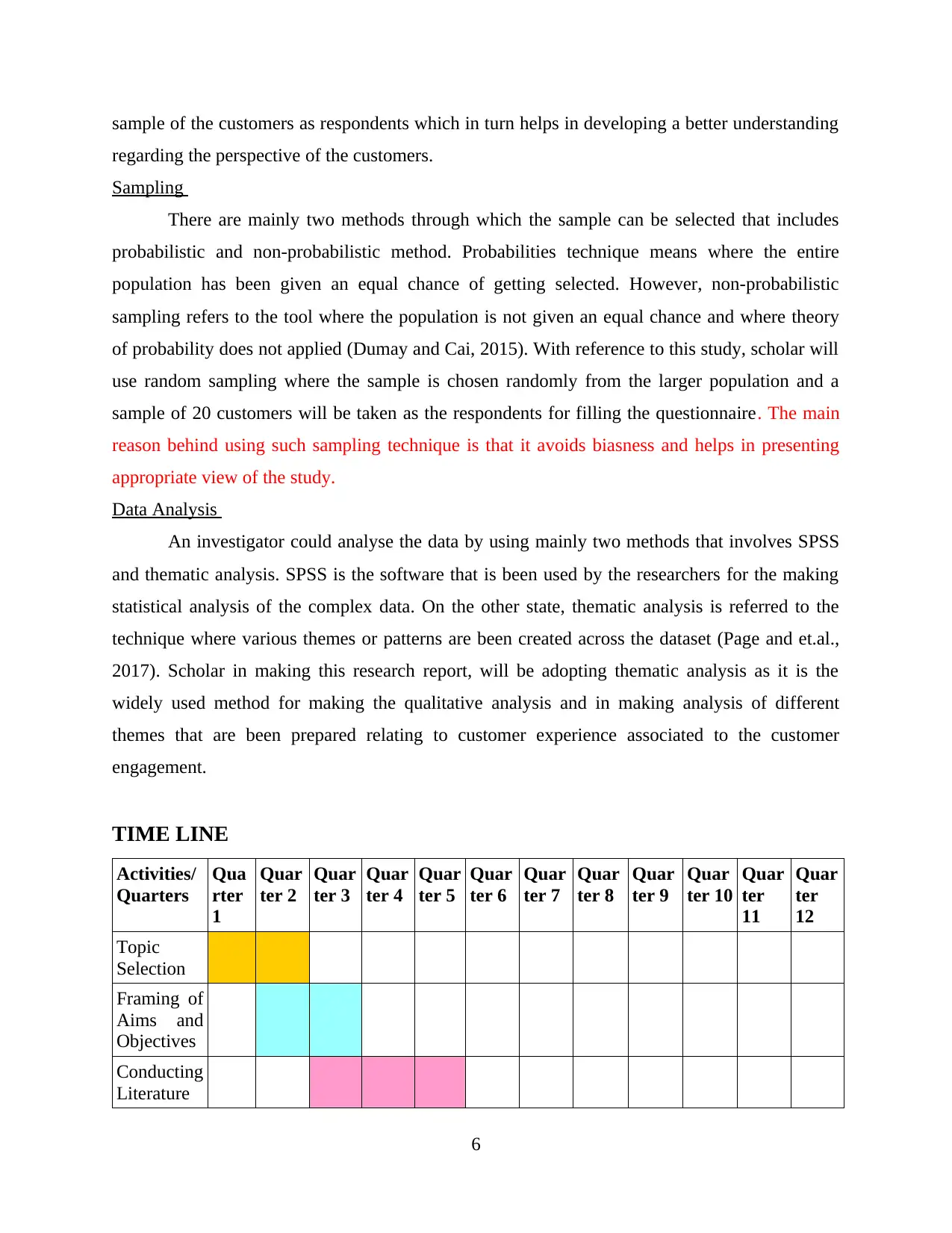
sample of the customers as respondents which in turn helps in developing a better understanding
regarding the perspective of the customers.
Sampling
There are mainly two methods through which the sample can be selected that includes
probabilistic and non-probabilistic method. Probabilities technique means where the entire
population has been given an equal chance of getting selected. However, non-probabilistic
sampling refers to the tool where the population is not given an equal chance and where theory
of probability does not applied (Dumay and Cai, 2015). With reference to this study, scholar will
use random sampling where the sample is chosen randomly from the larger population and a
sample of 20 customers will be taken as the respondents for filling the questionnaire. The main
reason behind using such sampling technique is that it avoids biasness and helps in presenting
appropriate view of the study.
Data Analysis
An investigator could analyse the data by using mainly two methods that involves SPSS
and thematic analysis. SPSS is the software that is been used by the researchers for the making
statistical analysis of the complex data. On the other state, thematic analysis is referred to the
technique where various themes or patterns are been created across the dataset (Page and et.al.,
2017). Scholar in making this research report, will be adopting thematic analysis as it is the
widely used method for making the qualitative analysis and in making analysis of different
themes that are been prepared relating to customer experience associated to the customer
engagement.
TIME LINE
Activities/
Quarters
Qua
rter
1
Quar
ter 2
Quar
ter 3
Quar
ter 4
Quar
ter 5
Quar
ter 6
Quar
ter 7
Quar
ter 8
Quar
ter 9
Quar
ter 10
Quar
ter
11
Quar
ter
12
Topic
Selection
Framing of
Aims and
Objectives
Conducting
Literature
6
regarding the perspective of the customers.
Sampling
There are mainly two methods through which the sample can be selected that includes
probabilistic and non-probabilistic method. Probabilities technique means where the entire
population has been given an equal chance of getting selected. However, non-probabilistic
sampling refers to the tool where the population is not given an equal chance and where theory
of probability does not applied (Dumay and Cai, 2015). With reference to this study, scholar will
use random sampling where the sample is chosen randomly from the larger population and a
sample of 20 customers will be taken as the respondents for filling the questionnaire. The main
reason behind using such sampling technique is that it avoids biasness and helps in presenting
appropriate view of the study.
Data Analysis
An investigator could analyse the data by using mainly two methods that involves SPSS
and thematic analysis. SPSS is the software that is been used by the researchers for the making
statistical analysis of the complex data. On the other state, thematic analysis is referred to the
technique where various themes or patterns are been created across the dataset (Page and et.al.,
2017). Scholar in making this research report, will be adopting thematic analysis as it is the
widely used method for making the qualitative analysis and in making analysis of different
themes that are been prepared relating to customer experience associated to the customer
engagement.
TIME LINE
Activities/
Quarters
Qua
rter
1
Quar
ter 2
Quar
ter 3
Quar
ter 4
Quar
ter 5
Quar
ter 6
Quar
ter 7
Quar
ter 8
Quar
ter 9
Quar
ter 10
Quar
ter
11
Quar
ter
12
Topic
Selection
Framing of
Aims and
Objectives
Conducting
Literature
6
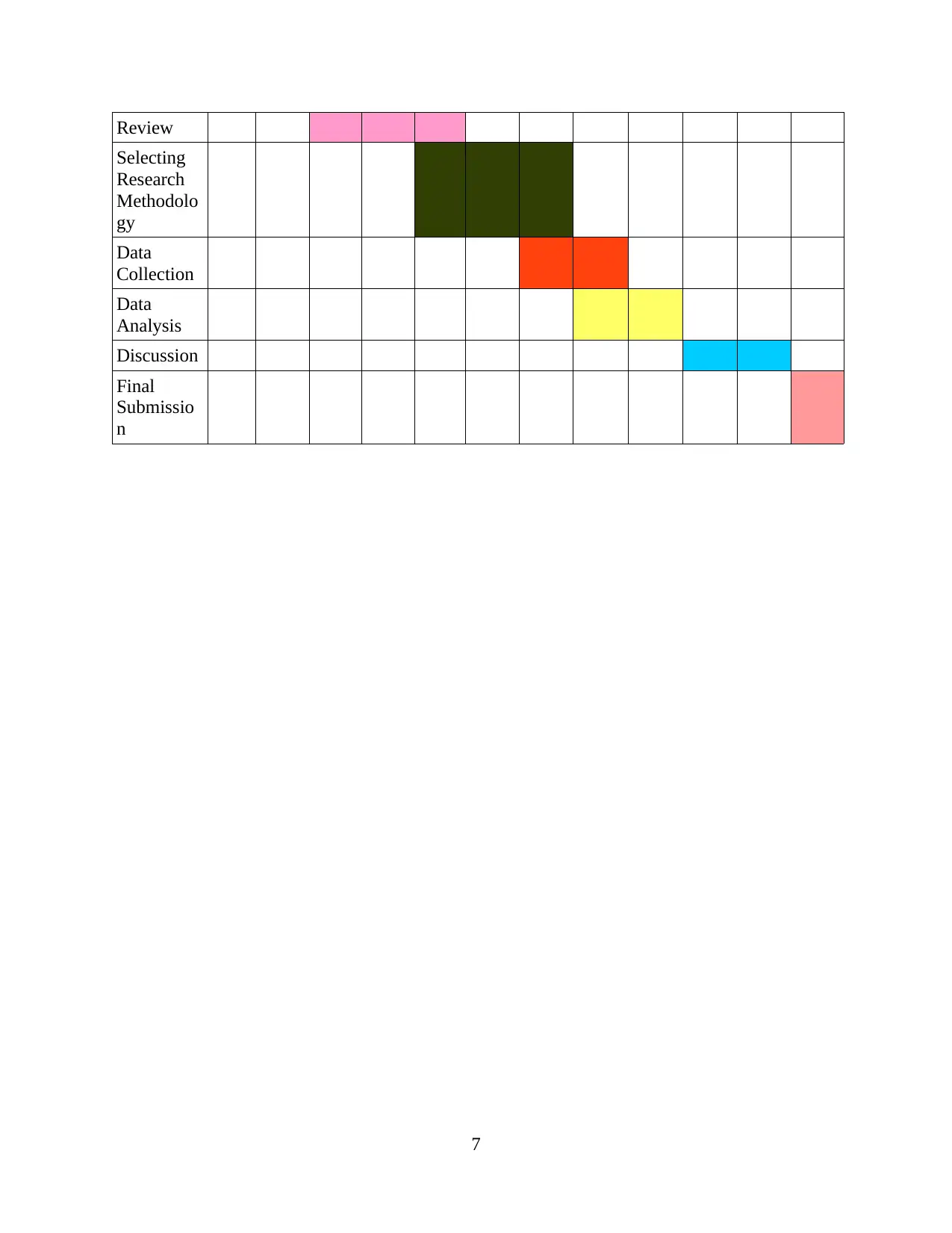
Review
Selecting
Research
Methodolo
gy
Data
Collection
Data
Analysis
Discussion
Final
Submissio
n
7
Selecting
Research
Methodolo
gy
Data
Collection
Data
Analysis
Discussion
Final
Submissio
n
7
⊘ This is a preview!⊘
Do you want full access?
Subscribe today to unlock all pages.

Trusted by 1+ million students worldwide
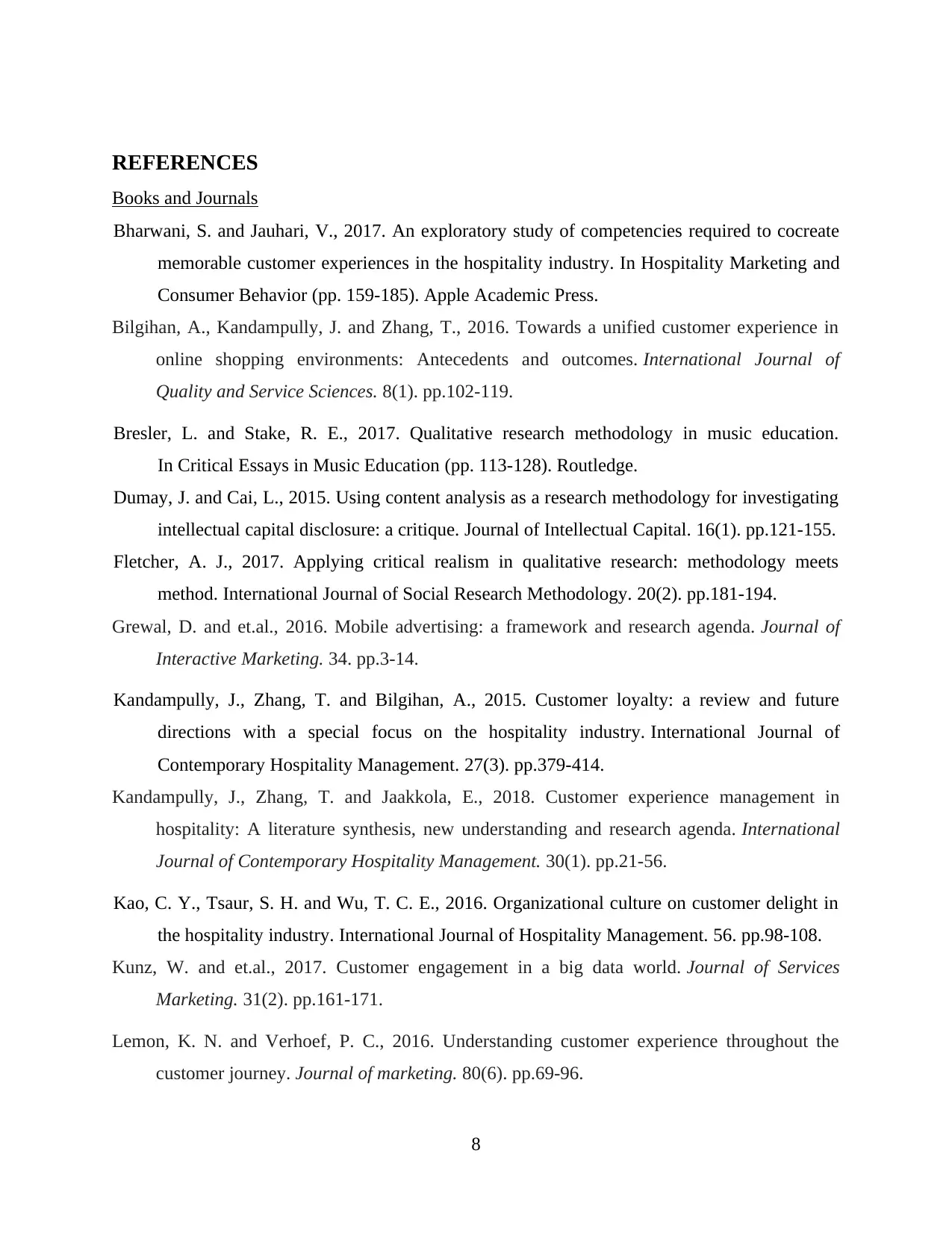
REFERENCES
Books and Journals
Bharwani, S. and Jauhari, V., 2017. An exploratory study of competencies required to cocreate
memorable customer experiences in the hospitality industry. In Hospitality Marketing and
Consumer Behavior (pp. 159-185). Apple Academic Press.
Bilgihan, A., Kandampully, J. and Zhang, T., 2016. Towards a unified customer experience in
online shopping environments: Antecedents and outcomes. International Journal of
Quality and Service Sciences. 8(1). pp.102-119.
Bresler, L. and Stake, R. E., 2017. Qualitative research methodology in music education.
In Critical Essays in Music Education (pp. 113-128). Routledge.
Dumay, J. and Cai, L., 2015. Using content analysis as a research methodology for investigating
intellectual capital disclosure: a critique. Journal of Intellectual Capital. 16(1). pp.121-155.
Fletcher, A. J., 2017. Applying critical realism in qualitative research: methodology meets
method. International Journal of Social Research Methodology. 20(2). pp.181-194.
Grewal, D. and et.al., 2016. Mobile advertising: a framework and research agenda. Journal of
Interactive Marketing. 34. pp.3-14.
Kandampully, J., Zhang, T. and Bilgihan, A., 2015. Customer loyalty: a review and future
directions with a special focus on the hospitality industry. International Journal of
Contemporary Hospitality Management. 27(3). pp.379-414.
Kandampully, J., Zhang, T. and Jaakkola, E., 2018. Customer experience management in
hospitality: A literature synthesis, new understanding and research agenda. International
Journal of Contemporary Hospitality Management. 30(1). pp.21-56.
Kao, C. Y., Tsaur, S. H. and Wu, T. C. E., 2016. Organizational culture on customer delight in
the hospitality industry. International Journal of Hospitality Management. 56. pp.98-108.
Kunz, W. and et.al., 2017. Customer engagement in a big data world. Journal of Services
Marketing. 31(2). pp.161-171.
Lemon, K. N. and Verhoef, P. C., 2016. Understanding customer experience throughout the
customer journey. Journal of marketing. 80(6). pp.69-96.
8
Books and Journals
Bharwani, S. and Jauhari, V., 2017. An exploratory study of competencies required to cocreate
memorable customer experiences in the hospitality industry. In Hospitality Marketing and
Consumer Behavior (pp. 159-185). Apple Academic Press.
Bilgihan, A., Kandampully, J. and Zhang, T., 2016. Towards a unified customer experience in
online shopping environments: Antecedents and outcomes. International Journal of
Quality and Service Sciences. 8(1). pp.102-119.
Bresler, L. and Stake, R. E., 2017. Qualitative research methodology in music education.
In Critical Essays in Music Education (pp. 113-128). Routledge.
Dumay, J. and Cai, L., 2015. Using content analysis as a research methodology for investigating
intellectual capital disclosure: a critique. Journal of Intellectual Capital. 16(1). pp.121-155.
Fletcher, A. J., 2017. Applying critical realism in qualitative research: methodology meets
method. International Journal of Social Research Methodology. 20(2). pp.181-194.
Grewal, D. and et.al., 2016. Mobile advertising: a framework and research agenda. Journal of
Interactive Marketing. 34. pp.3-14.
Kandampully, J., Zhang, T. and Bilgihan, A., 2015. Customer loyalty: a review and future
directions with a special focus on the hospitality industry. International Journal of
Contemporary Hospitality Management. 27(3). pp.379-414.
Kandampully, J., Zhang, T. and Jaakkola, E., 2018. Customer experience management in
hospitality: A literature synthesis, new understanding and research agenda. International
Journal of Contemporary Hospitality Management. 30(1). pp.21-56.
Kao, C. Y., Tsaur, S. H. and Wu, T. C. E., 2016. Organizational culture on customer delight in
the hospitality industry. International Journal of Hospitality Management. 56. pp.98-108.
Kunz, W. and et.al., 2017. Customer engagement in a big data world. Journal of Services
Marketing. 31(2). pp.161-171.
Lemon, K. N. and Verhoef, P. C., 2016. Understanding customer experience throughout the
customer journey. Journal of marketing. 80(6). pp.69-96.
8
Paraphrase This Document
Need a fresh take? Get an instant paraphrase of this document with our AI Paraphraser
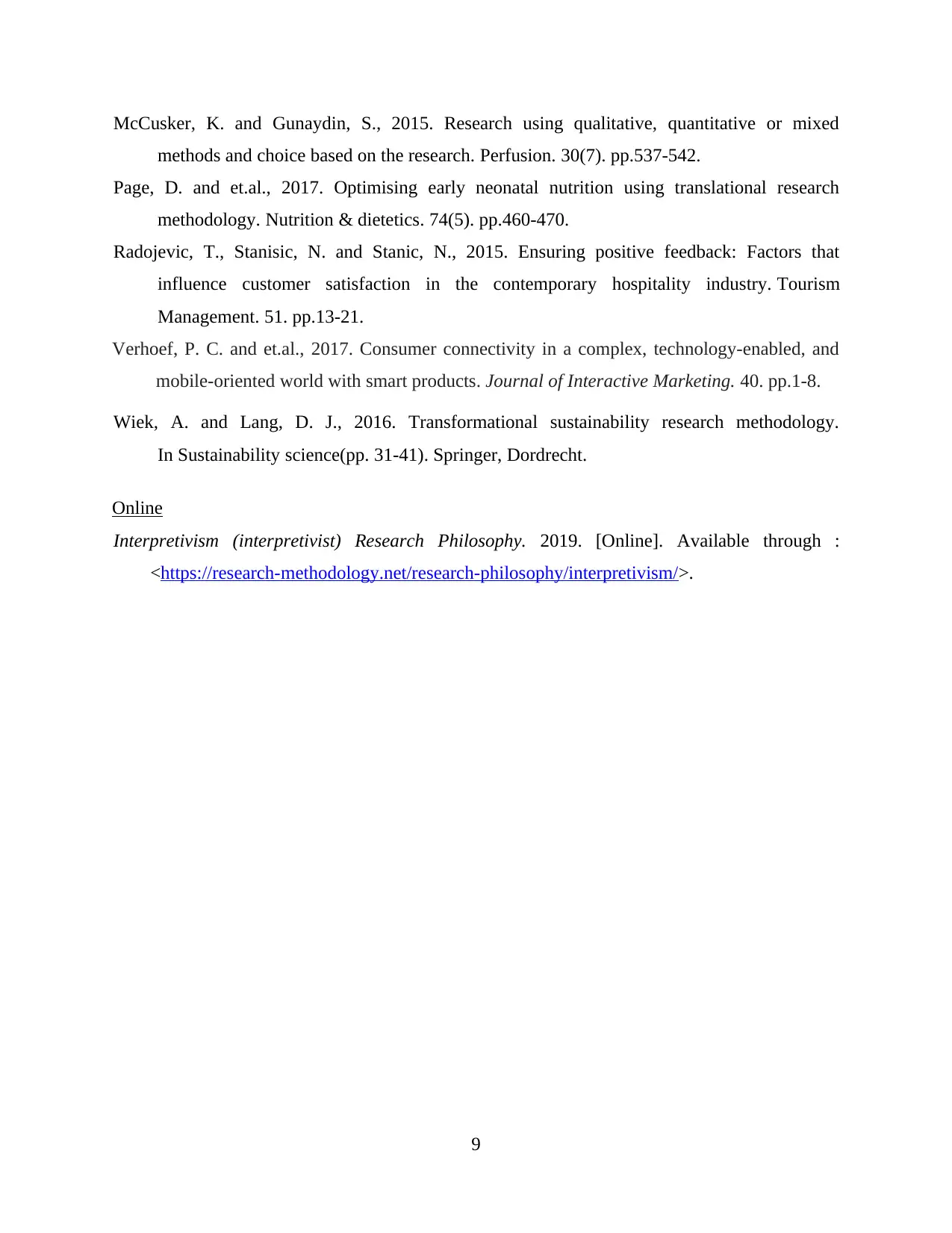
McCusker, K. and Gunaydin, S., 2015. Research using qualitative, quantitative or mixed
methods and choice based on the research. Perfusion. 30(7). pp.537-542.
Page, D. and et.al., 2017. Optimising early neonatal nutrition using translational research
methodology. Nutrition & dietetics. 74(5). pp.460-470.
Radojevic, T., Stanisic, N. and Stanic, N., 2015. Ensuring positive feedback: Factors that
influence customer satisfaction in the contemporary hospitality industry. Tourism
Management. 51. pp.13-21.
Verhoef, P. C. and et.al., 2017. Consumer connectivity in a complex, technology-enabled, and
mobile-oriented world with smart products. Journal of Interactive Marketing. 40. pp.1-8.
Wiek, A. and Lang, D. J., 2016. Transformational sustainability research methodology.
In Sustainability science(pp. 31-41). Springer, Dordrecht.
Online
Interpretivism (interpretivist) Research Philosophy. 2019. [Online]. Available through :
<https://research-methodology.net/research-philosophy/interpretivism/>.
9
methods and choice based on the research. Perfusion. 30(7). pp.537-542.
Page, D. and et.al., 2017. Optimising early neonatal nutrition using translational research
methodology. Nutrition & dietetics. 74(5). pp.460-470.
Radojevic, T., Stanisic, N. and Stanic, N., 2015. Ensuring positive feedback: Factors that
influence customer satisfaction in the contemporary hospitality industry. Tourism
Management. 51. pp.13-21.
Verhoef, P. C. and et.al., 2017. Consumer connectivity in a complex, technology-enabled, and
mobile-oriented world with smart products. Journal of Interactive Marketing. 40. pp.1-8.
Wiek, A. and Lang, D. J., 2016. Transformational sustainability research methodology.
In Sustainability science(pp. 31-41). Springer, Dordrecht.
Online
Interpretivism (interpretivist) Research Philosophy. 2019. [Online]. Available through :
<https://research-methodology.net/research-philosophy/interpretivism/>.
9
1 out of 11
Related Documents
Your All-in-One AI-Powered Toolkit for Academic Success.
+13062052269
info@desklib.com
Available 24*7 on WhatsApp / Email
![[object Object]](/_next/static/media/star-bottom.7253800d.svg)
Unlock your academic potential
Copyright © 2020–2025 A2Z Services. All Rights Reserved. Developed and managed by ZUCOL.





